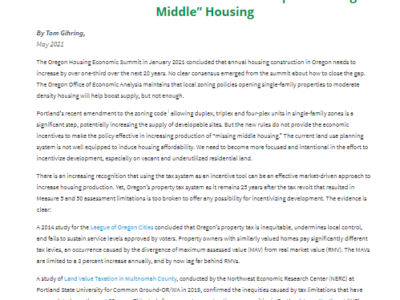In the months following the passage of Portland’s new Inclusionary Zoning Code, the program stalled as property developers sought to avoid regulations designed to leverage new affordable housing units from added building floor area granted as a quid pro quo. Now, the city proposes to offer more property tax inducements to attract new applications. The city wants to maximize affordable units; developers want to maximize profits. How do we find a balance? Read more…
Portland’s Inclusionary Housing Policy Needs Transparency
The Portland Tribune 16 May 2017
Excerpts:
The city’s Inclusionary Zoning Code went into effect on February 1 of this year. As a regulatory instrument to leverage new affordable housing units, it requires new housing developments over 20 units to set aside a specified percentage of below market rate units affordable to households with below median incomes. To offset the loss in revenue from lower-priced units, the code allows several incentives to developers beginning with additional building floor area granted – basically a rezone. This provides added income from the additional units within the bonused floor area. Other incentives include tax waivers and lower parking ratio standards.
During the process of formulating the code, the Planning and Housing bureaus attempted to build a consensus around a quid pro quo or “offsets” that returns the public benefit of affordable housing at a value equivalent to the incentives given to the owner-developers subject to the IZ code. Those incentives must be fair and equitable from the perspective of both owner-investors and the taxpaying public – not too minimal as to impose a burden on the owners, and not too excessive as to constitute a windfall at the city’s and taxpayers’ expense. But at the program’s outset, a divergence of views emerged. City councilors expressed confidence that the offsets and incentives were calibrated correctly, whilst a coalition of developers claimed the benefits were not strong enough to assure financing feasibility.
In the months following the IZ code’s passage, the program stalled. As the new code worked its way through city council, developers rushed to file permit applications for new projects before the program took effect on February 1 – for about 14,000 multifamily units. By mid-May only five permits were submitted, most for projects receiving Housing Bureau assistance.
Now, the city wants to offer more property tax inducements to attract new applications, including an expansion of the Multiple-unit Limited Tax Exemption. Moreover, the Housing Bureau is in the process of kicking off a new voluntary opt-in to the inclusionary program. This will involve a re-calibration of the offsets for providing affordable units.
Where is all this headed? The city wants to maximize the leverage of affordable units; developers want to maximize the profits they make from new development projects. How do we find the balance, requiring an offset that yields just enough affordable units to leave a fair return on investment? The better way to accomplish this is for all players to know what the projected return is for each proposed development application submitted.
A public disclosure rule is the most straightforward means to accomplish this. That is — full disclosure of each proposed project’s financials – cost figures, market rents, income projections, terms of subsidy (or incentive such as increased Floor Area Ratio) and the calculations that produce estimates of return on investment – that is the complete pro forma prepared by the project applicant, line-by-line. Most developers are averse to this, but there is ample evidence of states enacting laws on subsidy disclosure. If a public benefit is conferred upon a private party, the public has a right to know the value and nature of the assets being granted.
Is there a precedent for public disclosure of financials for determining offsets to provide a public benefit? Yes. British Columbia has enacted a law: Community Benefits Contributions (CAC), administered by the Ministry of Community, Sport and Cultural Development. When a local government rezones land, the land’s value increases, providing a benefit to the owner or developer. The government then captures a part of that increase to help fund a public benefit – normally infrastructure or below market rate housing. Local governments do not have the legal authority to rezone sites on the condition that permit applicants pay CACs. Rather, CACs are obtained through a negotiation process which must be carefully managed so as not to decrease the supply of new housing and increase housing prices.
Here is a brief description of the process: The developer provides the city with a pro forma, including estimated costs and income from a proposed project. Both parties determine the value of the property under existing zoning, then the value increase after rezoning, comparing profit margins under both scenarios. A CAC is determined from an agreed upon percentage of increase in the property value, typically 70 – 80 percent.
The negotiation process must be carefully structured to avoid adverserial positions when reaching an agreement. To prevent speculation during land assembly, the city does not recognize overpayments in the property transfer from existing owner to developer; this means the cost of the CAC will be reflected in the price offered to the owner. In the case of housing development, developers are required to keep the price or rent of the new units at the level commensurate with the set profit margin.
If the City of Portland is now considering a new voluntary opt-in to the inclusionary program, this should open the door to a provision similar to the CAC. Rather than recalibrating offsets, would it not be more fair and efficient to use publicly disclosed pro formas to negotiate the same? Why should the city bureaus and housing community have access to financial spreadsheets? Because public accountability calls for oversight and transparency.
The Short Guide – Community Amenity Contributions: Balancing Community Planning, Public Benefits and Housing Affordability, Ministry of Community, Sport and Cultural Development, March 2014




